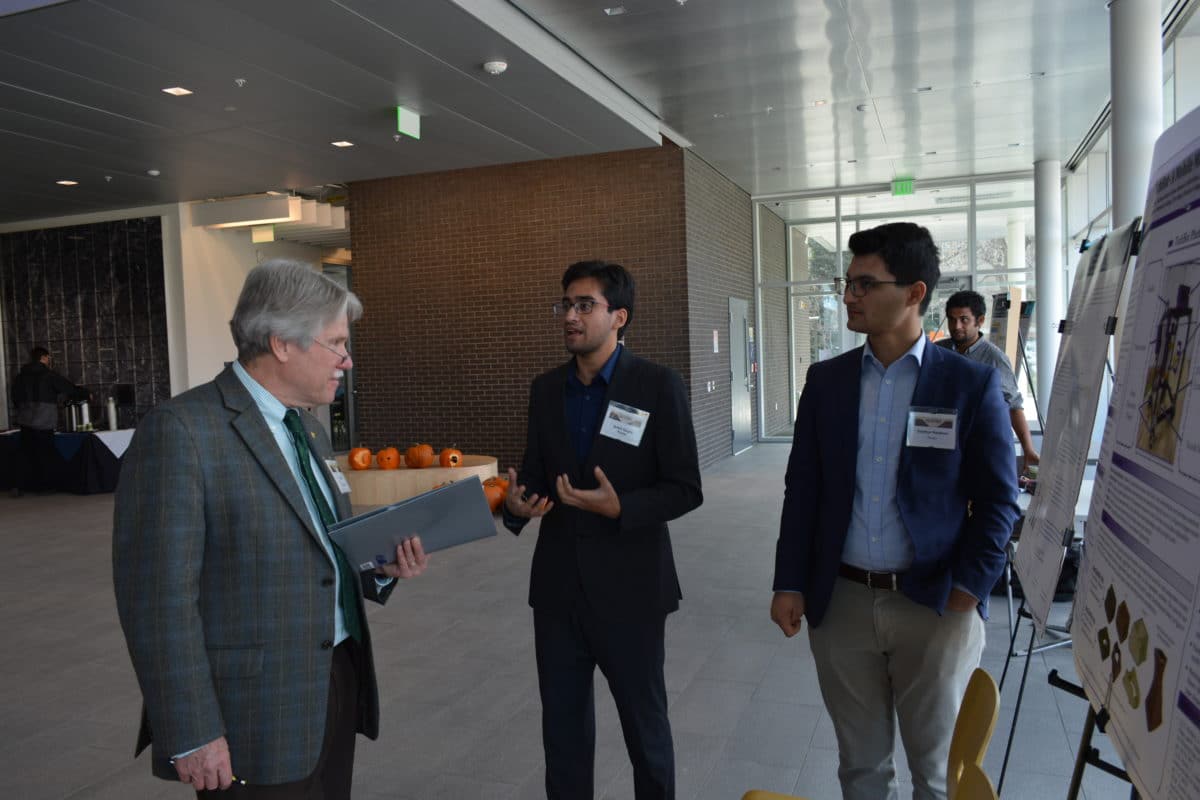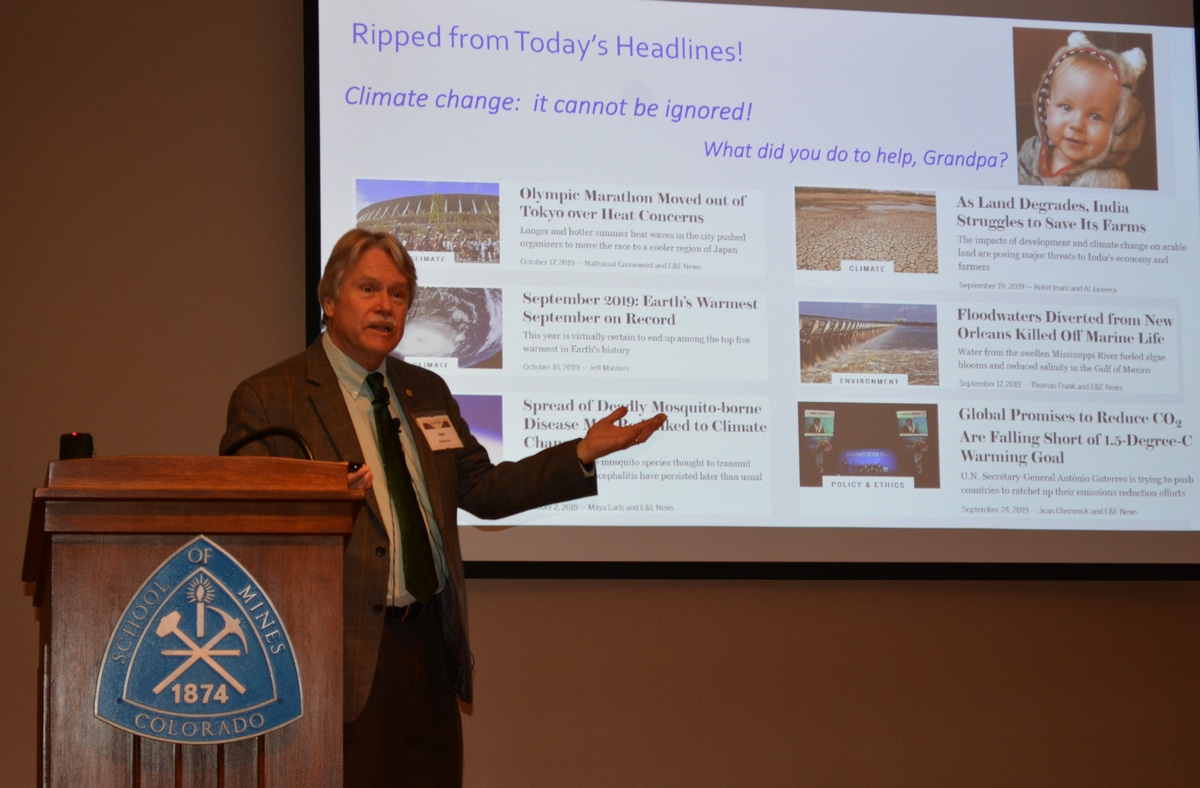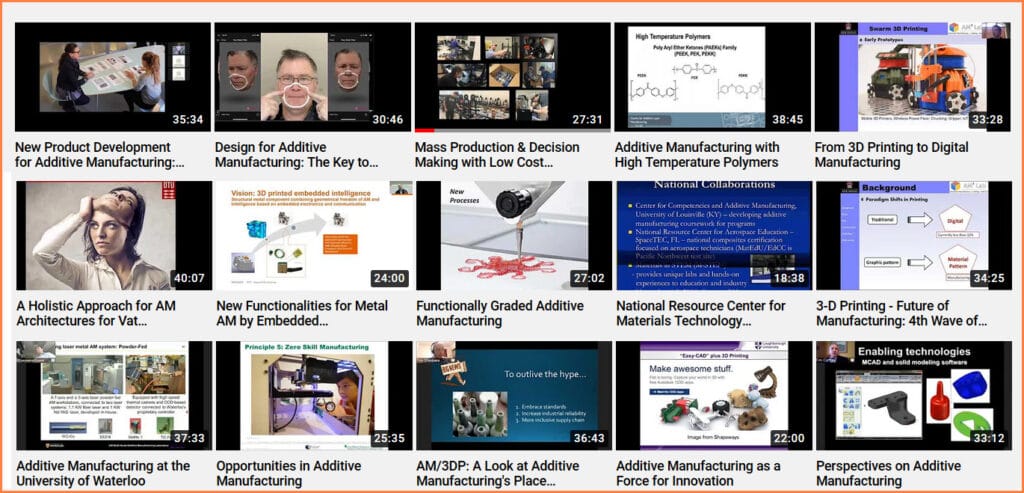
The College of Engineering at Tennessee Tech recently completed its well-known Golden Eagle Additively Innovative Lecture Series for Fall 2020. Under Dr. Ismail Fidan and his team, four experts — from nearby Somerset Community College in Kentucky to institutions spanning the globe in New Zealand, Norway, and the Netherlands — presented this semester on advanced Additive Manufacturing topics.
With 45 lectures recorded since the Spring semester of 2016, there is a range and depth available for just about anyone interested in learning about Additive Manufacturing. We wrote about the Tennessee Tech Announces Fall 2020 Additive Manufacturing Lecture Series as the school year got started. Despite COVID-19 shifting the world into online classrooms, Dr. Fidan has been using this virtual method, via Zoom, since the start of the program. One could definitely say he is an early adopter and visionary for making learning accessible and increasing TTU’s Engineering student access to world-renowned experts.
Early in 2020, the team decided to launch a YouTube channel as a way to share all of these lectures to an even wider audience. You can access the full Additively Innovative Lecture Series Archive, but we list out the titles below so that you can get an idea of the topic and niche diversity. On the archive page, each title takes you directly to the YouTube video. Perusing the list on the YouTube channel is not as straightforward, in this editor’s opinion, and so your time may be better spent picking from the list of video links from the archive directly.
Again, Bravo to the TTU team and Dr. Fidan for a semester filled with knowledge sharing and deeper insights into what makes Additive Manufacturing (aka 3D Printing) useful, valuable, and world changing.
**Oh, and don’t forget to subscribe to their new YouTube channel.
To the Archives!:
Fall 2020 Lectures (Please note these lectures may not all be uploaded to YouTube yet)
-
-
- Mass Production and Decision Making with Low Cost Additive Manufacturing for Institutions and Small Businesses
- Design for AM: The Key to the Industrialization of AM
- New Product Development for AM: Methods and Tools
- Machine Learning in AM
-
Spring 2020 Lectures
-
-
- New Functionalities for Metal AM by Embedded Intelligence, Puukko Pasi, VTT Technical Research Centre of Finland, Ltd.
- A Holistic Approach to Achieving the Best Possible Component Quality for AM Architectures for Vat Photopolymer and Laser Powder Bed Fusion Systems, David Bue Pedersen, Technical University of Denmark
- Additive Manufacturing with High Temperature Polymers, Oana Ghita, University of Exeter
- From 3D Printing to Digital Manufacturing, Wenchao Zhou, University of Arkansas
-
Fall 2019 Lectures
-
-
- Generative Design Will Change the Future of Manufacturing, Shashi Jain, Intel Corporation
- Sustaining Accessibility for Kids’ Creativity with Additive Manufacturing, Pisut Koomsap, Asian Institute of Technology
- Design and Additive Manufacturing of Porous Titanium Scaffolds for Optimum Cell Viability in Bone Tissue Engineering, Bingbing Li, California State University
- FDM-based Metal Additive Manufacturing, Haijun Gong, Georgia Southern University
-
Spring 2019 Lectures
-
-
- The Phantom Hole Technique, Improving Structural Performance in FFF/FDM 3D Printed Products, Eric Wooldridge, Somerset Community College
- Understanding Powder Bed Additive Manufacturing, Josh Dennis, EOS North America
- Preparing Your Model for 3D Printing, Adam Wills, Tennessee College of Applied Technology Nashville
- Project iGen: Using Additive Manufacturing for Service Learning, Amy Fricks, DeKalb County High School
-
Fall 2018 Lectures
-
-
- Functionally Graded Additive Manufacturing, Eujin Pei, Brunel University
- Design for Additive Manufacturing: The Key to the Industrial Adoption of Additive Manufacturing, Olaf Diegel, Lund University
- Where’s my Spare Part? Changing Maintenance, Repair, and Overhaul through Additive Manufacturing, Brett Conner, Youngstown State University
- Integrating Additive Manufacturing into CAD Courses, Tom Singer, Sinclair Community College
-
Spring 2018 Lectures
-
-
- Dental 3-D Printing Overview, Frank Alifui-Segbaya, Griffith University
- AM Research and Applications for Real World Production and Impact, Eric Wooldridge, Somerset Community College
- Free and Easy Software for Designing for 3-D Printing, Tim Gornet, Rapid Prototyping Center, University of Louisville
- Wire + Arc Additive Manufacturing: Enabling 10-Meter Parts, Filomeno Martina, Welding Engineering and Laser Processing Center, Cranfield University
-
Fall 2017 Lectures
-
-
- Next Generation Manufacturing: Professional and Technical Skills for the 21st Century Workforce, Karen Wosczyna-Birch, Center for Next Generation Manufacturing
- Using 3-D Printed Parts to Couple Festo Didatic’s MecLab Stations in an Assembly Process, Khalid Tantawi, Department of Career Readiness-Mechatronics, Motlow State Community College
- 3-D Printing, Design Thinking, and the Entrepreneurial Mindset, Phan Tran, Center for Architecture, Design, and Engineering, Lake Washington Institute of Technology
- Workflow of the Additive Manufacturing Process, Kyle Bates-Green, National Resource Center for Materials Technology Education
-
Spring 2017 Lectures
-
-
- Bioprinting and Tissue Engineering, Yunzhi Peter Yang, Medical Scholar Program in Bioengineering Scholarly Concentration, Stanford University
- Making It Work, Marilyn Barger, NSF Florida Advanced Technological Education Center, Hillsborough Community College
- Additive Manufacturing: Instrumental Systems in Research, Education, and Service, Bahram Asiabanpour, Ingram School of Engineering at Texas State University
- A Technique for Quick Introduction of 3-D Design and Prototyping, Hugh Jack, School of Engineering and Technology, Western Carolina University
-
Fall 2016 Lectures
-
-
- Marketing Your Maker Business, TJ McCue
- Content and Curriculum Development Efforts in 3-D Printing, Jesse Roitenbert, Stratasys
- The Development of a Framework for 3-D Printing, Casting, & Entrepreneurship, Jay Watson, Cookeville High School
- 3-D Printed Joints and Connectors for Assemblies, Nick Russell and Jacob Floyd, Tennessee Tech University
-
Spring 2016 Lectures
-
-
- Mel Cossette and Robin Ballard, National Resource Center for Materials Technology Education
- 3-D Printing – Future of Manufacturing: The 4th Wave of Human Civilization, Wenchao Zhou, University of Arkansas
- Additive Manufacturing at the University of Waterloo, Ehsan Toyserkani, University of Waterloo
- Opportunities in Additive Manufacturing, Amy Elliott, Oak Ridge National Laboratory
- AM/3DP Point-Counterpoint: A Look at AM’s Place Among the Headlines, Business, and Industry, Peter Yang, Stanford University
- Additive Manufacturing as a Force for Innovation, Ian Campbell, Loughborough University
- Perspectives on Additive Manufacturing, Tim Caffrey, Wohlers Associates
- History of Additive Manufacturing, David Bourell, University of Texas at Austin
- Additive Manufacturing Today and in the Future, Terry Wohlers, Wohlers Associates
-
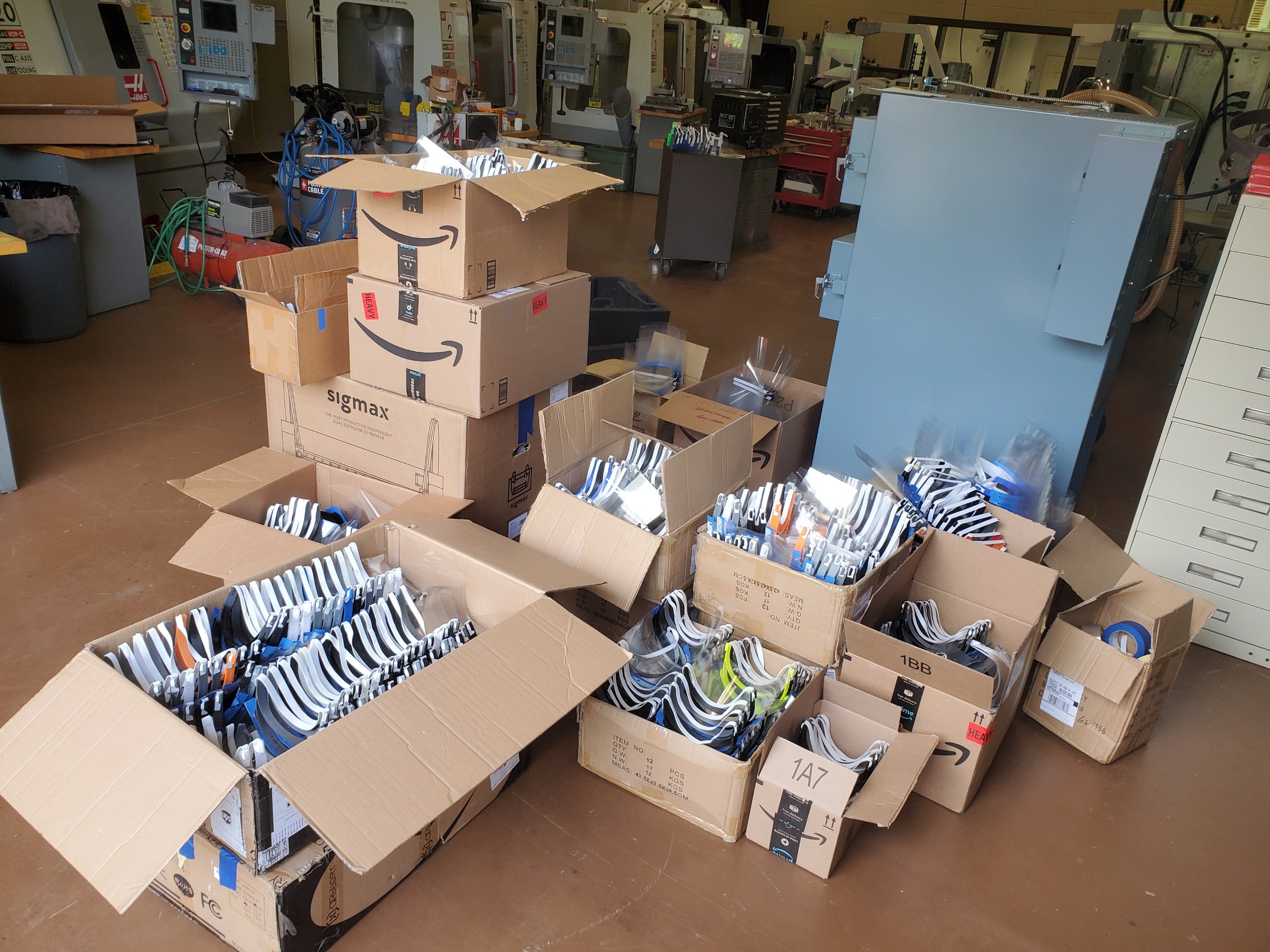


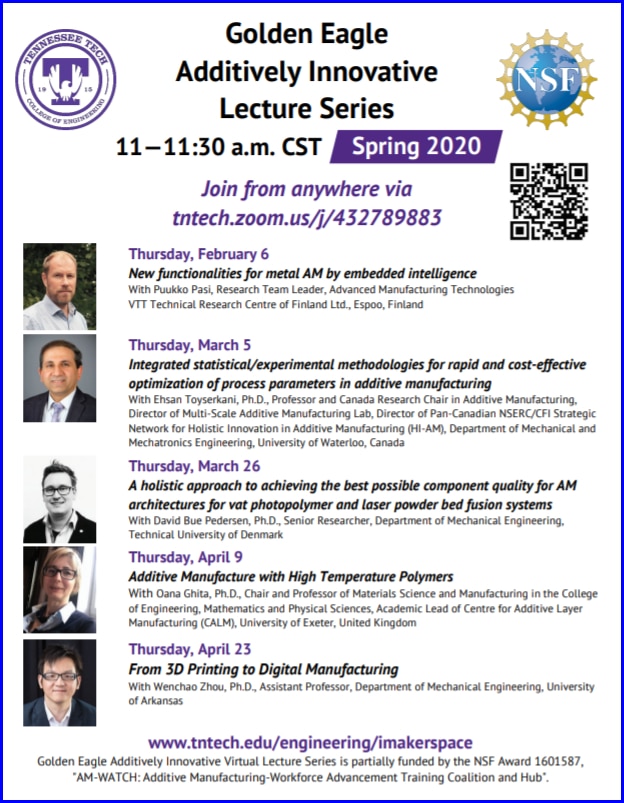
 Thursday, February 6
Thursday, February 6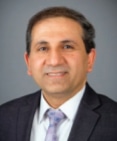 Thursday, March 5
Thursday, March 5 Thursday, March 26
Thursday, March 26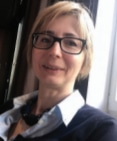 Thursday, April 9
Thursday, April 9 Thursday, April 23
Thursday, April 23